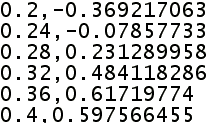From the Function Builder, you can define motor or force profiles from interpolated samples of a function of time or cycle angle.
Some Function Builder options are not available for Animation or Basic Motion study types.
-
From the Motor or Force PropertyManager, under Type, click Data Points
 .
.
- Select the independent variable:
The independent variable defines the horizontal axis for each function.
- Select the function Value:
- Displacement
- Velocity
- Acceleration
For path mate motors in
Motion Analysis type studies, select from the following:
- Distance Along Path
- Tangential Velocity
- Tangential Acceleration
-
Select the Interpolation type:
-
Linear
- Cubic Spline
- Akima Spline
-
Click Import Data and select the .txt or .csv file containing two-column function data in a comma-separated file.
The first entry of each row defines a value of the independent variable and the second entry is the value of the corresponding dependent variable.

- To add individual data points that follow the current data set, select Click to add row and enter the independent variable and value data.
-
To enter an intermediary data point to the imported data set:
-
Right-click the file data row of the table and click Expand.
You cannot undo this step.
- Right-click the row for the point in the data set that succeeds the intermediary point and click Insert Row Above.
- Enter the intermediary point data in the new row.
For motor profiles, you can view displacement, velocity, acceleration, and jerk in the
Function Builder. For force profiles, you can view a plot of the force profile.
- Click OK.
Before clicking OK, you can select Make function available to define other motors or forces for this model and enter a function Name. The function name appears in the PropertyManager.